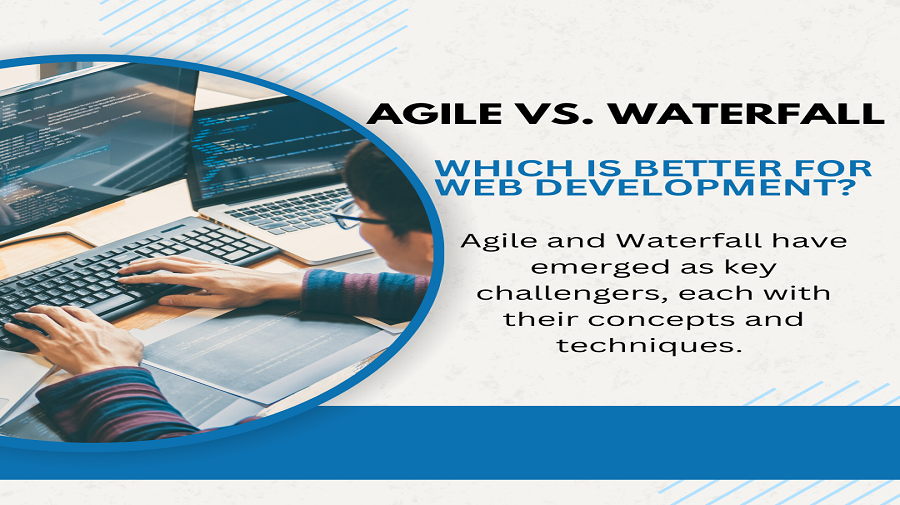Agile vs. Waterfall: Which Is Better for Web Development?

Choosing the right technique in web development becomes as important as anything else for project success. Agile and Waterfall have emerged as key challengers, each with their concepts and techniques. We dig into the complexities of Agile and Waterfall techniques. We will deconstruct their benefits, drawbacks, and application to web development projects. To improve productivity and quality, organizations need to understand these approaches and streamline workflows. Join us on this trip as we examine the subtleties, benefits, and trade-offs inherent in Agile and Waterfall approaches to assist decision-makers in picking the best strategy for their web development initiatives.
What is Agile Methodology
————————————–
Agile methodology is an adaptable and collaborative approach to software development. It stresses client satisfaction and adaptation. It is based on iterative and incremental development. It involves breaking down the project into tiny, manageable steps and producing usable software in short cycles. This enables continual improvement as well as rapid response to changing requirements. Customer cooperation, adapting to change by following a plan, and respecting persons and interactions are all key Agile concepts.
Key responsibilities in an Agile development team include the Scrum Master. It organizes the process and removes barriers, the Product Owner, who represents the client and specifies project requirements, and the Team, which collaborates to create high-quality work. The benefits of Agile in web development are numerous. It includes enhanced flexibility, faster time-to-market, improved communication, and the capacity to react to changing client demands. Hence resulting in a more efficient and customer-focused development process.
Agile web development allows for better adaptation to changing SEO and digital marketing trends. The development team, SEO professionals, and digital marketers communicate regularly. This keeps the website technically solid and optimized for search engines. It also aligns with marketing goals.
Exploring Waterfall Methodology
————————————–
The waterfall technique is a typical project management style distinguished by a sequential and linear movement through discrete phases. The Waterfall approach is commonly used in web development. It consists of five consecutive stages: requirements, design, implementation, testing, and deployment. The process starts with gathering and specifying project requirements. It then moves to the design phase, where the system architecture is planned. The implementation step involves real coding based on the concept and extensive testing to discover and correct errors. The project is sent into production at the end of the process.
Comparing Agile and Waterfall for Web Development
————————————–
Let’s compare Agile and Waterfall approaches in the context of web development in a variety of ways:
A. Flexibility and Adaptability:
Agile: Agile is noted for its adaptability and flexibility. It employs an iterative and incremental methodology. It enables for easy integration of modifications during the development process. It accepts feedback and enables changes depending on changing needs.
Waterfall: Waterfall, on the other hand, is an organised and sequential approach. You cannot go back and make modifications after last executed phase. It will damaging the entire project. When dealing with changing needs, it may lack adaptability.
B. Project Management and Client Involvement:
Agile: Agile emphasizes strong cooperation between development teams and clients throughout the project. Regular meetings and feedback sessions are regular. It ensures that the client’s needs are properly understood and satisfied. Project management is typically decentralized, with self-organizing teams.
Waterfall: Client participation is often at the beginning and conclusion of a Waterfall project. The client submits specifications in the beginning, and the completed product is supplied at the end. The project management is more centralized. There is less continuous customer engagement during the development period.
C. Handling Changes and Updates:
Agile: Agile is well-suited to dealing with change. It allows for changes in requirements even later in the development process. Changes are to be expected and are readily incorporated into continuous development cycles.
Waterfall: Managing changes in Waterfall might be difficult. Any changes in requirements after the project has begun may cause delays and cost overruns. Because of its stiff structure, it is less adaptive to changes.
D. Time and Cost Considerations:
Agile: Agile projects are often more time-efficient due to the incremental and iterative development strategy. Costs are spread out throughout the project. The client may see actual results from the beginning.
Waterfall: Waterfall projects may take longer since the complete system is constructed simultaneously. Costs are often concentrated at the end. The client may not see a concrete result until the last phases. It may constitute a risk if the given product does not fulfil expectations.
Let’s see some more differences between Agile and Waterfall methodologies:
————————————–
| Feature | Agile | Waterfall |
| Development Approach | Iterative and incremental | Sequential |
| Project Flexibility | Highly flexible and adaptable | Limited flexibility |
| Project Visibility | Continuous visibility and feedback | Limited visibility until the end |
| Client Involvement | Regular client involvement | Client involvement at the end |
| Change Management | Embraces changes during the project | Changes are difficult to implement |
| Delivery Time | Shorter delivery cycles | Longer delivery cycles |
| Risk Management | Early identification and mitigation | Risk addressed at project start |
| Testing | Continuous testing throughout | Testing at the end of development |
| Documentation | Minimal documentation initially | Comprehensive documentation upfront |
| Adaptability | Easily adaptable to changes | Difficult to adapt to changes |
| Team Collaboration | High collaboration and communication | Limited collaboration |
| Customer Satisfaction | Frequent feedback leads to higher customer satisfaction | Customer satisfaction determined at the end |
| Quality Control | Ongoing quality control and improvements | Quality control at the end |
Real-world Examples for Agile and Waterfall:
————————————–
1. Agile:
- Spotify: Spotify is a well-known music streaming business. They have implemented Agile principles to improve cooperation and adapt fast to changing market needs. They divide their teams into tiny, cross-functional squads that operate separately. Spotify has been able to develop and deploy new features due to its Agile strategy.
- Facebook: Facebook has a history of using Agile methodologies in its development operations. The firm places a premium on rapid iterations and frequent releases. They manage their projects effectively using Scrum and other Agile concepts. It allows them to respond quickly to customer feedback and stay ahead in the competitive social media scene.
- Netflix: A popular streaming network, Netflix has adopted Agile techniques to be flexible to consumer preferences and market developments. The company’s development teams organize their work using Agile methodologies. These are like Scrum, allowing them to continually produce new features and enhancements. This strategy is consistent with Netflix’s dedication to innovation and consumer pleasure.
2. Waterfall:
- NASA’s Apollo Program: The Apollo program, which planned to put humans on the moon, used a Waterfall technique in its development. Each aspect of the project, from concept to development and testing, was accomplished in order. This technique was adopted because of the project’s complexity and criticality, where each step must be completely tested before going on to the next.
- Automotive Industry (Traditional Manufacturing): Vehicle development in conventional automotive production frequently follows a Waterfall strategy. Design, engineering, prototyping, testing, and manufacturing all take place in a sequential order. While the automobile sector progressively embraces Agile concepts for particular components such as software development, the entire product development lifecycle may still follow a more staged and regimented Waterfall approach.
Making the Right Choice:
————————————–
Choosing the right development approach is critical in web development. The choice between Agile and Waterfall has significant consequences for project success. To decide, consider factors such as project scope, complexity, and client expectations. Agile is good at handling changing requirements and customer needs because it can adapt. The waterfall method is better for projects with clear goals and few expected changes.
Finding the proper balance frequently entails connecting the selected technique to the project’s specifics and aligning it with customer expectations. By combining Agile and Waterfall methodologies, we can have flexibility and structure. We may find new ways to solve problems and work more efficiently by considering alternatives to the traditional divide. To make the best choice, understand the project needs, client relationships, and web development approaches.
Conclusion
The selection between Agile and Waterfall approaches for web development is subtly influenced by several factors, including project needs, team dynamics, and corporate goals. Both techniques have advantages and disadvantages, and the project’s unique environment determines the appropriateness of each. With its iterative and flexible character, Agile is advantageous in dynamic contexts where rapid changes and client cooperation are essential. It enables rapid adaptability to changing requirements, promotes continuous development, and increases customer satisfaction. Conversely, with its organized and sequential approach, Waterfall may be ideal for projects with well-defined and consistent needs, giving a clear roadmap and efficient project management.
The goal is to match the selected approach with the specific qualities and requirements of the project. Adopting a hybrid approach or tailoring the chosen technique to build a bespoke framework that ideally answers the project’s objectives is frequently advantageous. The success of web development projects depends on the technique used and its effective implementation, cooperation, and communication within the development team and with stakeholders.




